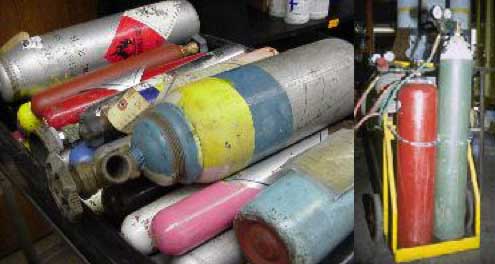 At Regis College, compressed gases are used in laboratories, Dining Services, and the Office of the Physical Plant. Compressed gases serve the university in many ways, but if improperly used or stored they can present a number of hazards. Mishandled cylinders may rupture violently, release their hazardous contents or become dangerous projectiles. If a neck of a pressurized cylinder should be accidentally broken off, the energy released would be sufficient to propel the cylinder to over three-quarters of a mile in height. A standard 250 cubic foot cylinder pressurized to 2,500 PSIG can become a rocket attaining a speed of over 30 miles per hour in a fraction of a second after venting from the broken cylinder connection.
At Regis College, compressed gases are used in laboratories, Dining Services, and the Office of the Physical Plant. Compressed gases serve the university in many ways, but if improperly used or stored they can present a number of hazards. Mishandled cylinders may rupture violently, release their hazardous contents or become dangerous projectiles. If a neck of a pressurized cylinder should be accidentally broken off, the energy released would be sufficient to propel the cylinder to over three-quarters of a mile in height. A standard 250 cubic foot cylinder pressurized to 2,500 PSIG can become a rocket attaining a speed of over 30 miles per hour in a fraction of a second after venting from the broken cylinder connection.
This fact sheet provides guidelines to help ensure the safe handling and storage of compressed gas cylinders:
Basic Safety
- Select the least hazardous gases that will work, purchase only the necessary quantities, and select gases with returnable containers.
- When receiving gas cylinders:
- Check for leaks
- Visually inspect the cylinder for damage. If a cylinder is damaged, in poor condition, leaking, or the contents are unknown, contact your cylinder vendor. Have the vendor return the damaged cylinder to the manufacturer.
- Ensure the valve cover and shipping cap is on, check for proper labeling.
- Proper personal protective equipment must be worn if required by your supervisor, instructor, or department.
- Always have an appropriate Safety Data Sheet (SDS)
- Check for leaks
Cylinder Markings
- Cylinders must be properly labeled, including the gas identity and appropriate hazards (e.g., health, flammability, reactivity).
- Cylinders have several stamped markings. The top mark is either a DOT or an ICC marking indicating pertinent regulations for that cylinder. The second mark is the serial number. Under the serial number is the symbol of the manufacturer, user, or purchaser. Of the remaining marks the numbers represent the date of manufacture, and retest date (month and year). A (+) sign indicates the cylinder may be 10% overcharged, and a star indicates a ten-year test interval.
Cylinder Storage
- Cylinders should be stored in compatible groups: flammables from oxidizers, corrosives from flammables, full cylinders from empties.
- Empty cylinders should be clearly marked and stored as carefully as those that are full because residual gas may be present.
- Store cylinders in an upright position.
- Keep oxygen cylinders a minimum of twenty feet from flammable gas cylinders or combustible materials. If this cannot be done, separation by a non-combustible barrier at least five feet high having a fire-rating of at least one-half hour is required.
- Compressed gas cylinders should be secured firmly at all times. A clamp and belt or chain, securing the cylinder between "waist" and "shoulder" to a wall, are generally suitable for this purpose.
- Cylinders should be individually secured; using a single restraint strap around a number of cylinders is often not effective.
- Keep valve protective caps in place when the cylinder is not in use.
- Mark empty cylinders EMPTY or MT.
- Keep valves closed on empty cylinders.
- Cylinders must be kept away from sources of heat.
- Cylinders must be kept away from electrical wiring where the cylinder could become part of the circuit.
- Store cylinders in well-ventilated areas designated and marked only for cylinders.
Moving Cylinders
- Use a cylinder cart and secure cylinders with a chain.
- Don't use the protective valve caps for moving or lifting cylinders.
- Don't drop a cylinder, or permit them to strike each other violently or be handled roughly.
- Unless cylinders are secured on a special cart, regulators shall be removed, valves closed and protective valve caps in place before cylinders are moved.
Cylinder Use
- Be sure all connections are tight. Use soapy water to locate leaks.
- Keep cylinders away from open flames and sources of heat.
- Safety devices and valves shall not be tampered with, nor repairs attempted.
- Regulators shall be removed when moving cylinders, when work is completed, and when cylinders are empty.
- Cylinders shall be used and stored in an upright position.
Things Not to Do
- Never roll a cylinder to move it.
- Never carry a cylinder by the valve.
- Never leave an open cylinder unattended.
- Never leave a cylinder unsecured.
- Never force improper attachments on to the wrong cylinder.
- Never grease or oil the regulator, valve, or fittings of an oxygen cylinder.
- Never refill a cylinder.
- Never use a flame to locate gas leaks.
- Never attempt to mix gases in a cylinder.
- Never discard pressurized cylinders in the normal trash.
Poison and Flammable Gases
Poison and flammable gas present significant hazards which require additional safe handling procedures when in use.
- Emergency procedures should be made clear to all involved, including personnel from adjacent labs and building managers.
- Notify the office of Environmental Health and Safety before using poison or flammable gas.
- The Regis College Police Department should also be informed about the locations and types of poison gas in use.
- Obtain and review the Safety Data Sheet (SDS) for the poison gas.